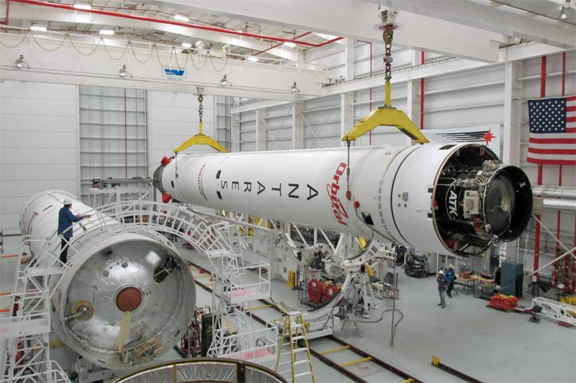
[SatNews] Orbital has established July 11, 2014 as the targeted date for the launch of the Orb-2 mission to the International Space Station (ISS), the second operational cargo resupply mission under the company’s Commercial Resupply Services (CRS) contract with NASA.

The Antares Rocket for the Orb-2 Mission is lifted onto the Transporter/Erector/Launcher (TEL). The stage one core for the next mission (Orb-3) is on the left of this photo.
Image courtesy of Orbital Sciences.
The targeted launch time from the Mid-Atlantic Regional Spaceport at NASA’s Wallops Flight Facility on July 11 will be 1:40 p.m. (EDT). The engineering team that is investigating the failure of an AJ26 engine during an acceptance test at Stennis Space Center recommended that certain inspections be performed on the two AJ26 engines that are currently integrated on the Antares rocket. These inspections were recently completed and program officials have cleared the rocket for flight.
Leading up to the launch, the Cygnus cargo logistics spacecraft will be mated to the rocket today. After the loading of the final time sensitive cargo and installation of the rocket’s payload fairing, Antares will be rolled out to the launch pad on July 9. A launch on July 11 will result in a rendezvous and berthing with the ISS on July 15. The Cygnus spacecraft will deliver 1,657 kg of cargo to the ISS and will be loaded with approximately 1,346 kg of material for disposal upon reentry into Earth’s atmosphere.
Cygnus will be boosted into orbit by a two-stage Antares rocket from Pad 0A at the Mid-Atlantic Regional Spaceport. The launch sequence will last about ten minutes from liftoff through the separation of Cygnus from the Antares vehicle. Once in orbit, Cygnus will deploy its solar arrays and undergo initial check-out. The spacecraft will then conduct a series of thruster burns to raise its orbit to bring it within 4 km of the ISS prior to receiving authorization to autonomously rendezvous with the station. When the vehicle approaches to within 12 meters, the astronauts will use the station’s robotic arm to grapple Cygnus and berth it to the Harmony node of the station.
Cygnus is planned to remain berthed at the ISS for approximately 40 days during which time the station crew will unload cargo from Cygnus and subsequently load it with materials for disposal. At the end of the mission Cygnus will depart the station and reenter the Earth’s atmosphere.
For further information, please visit the Orbital infosite at http://www.orbital.com/

